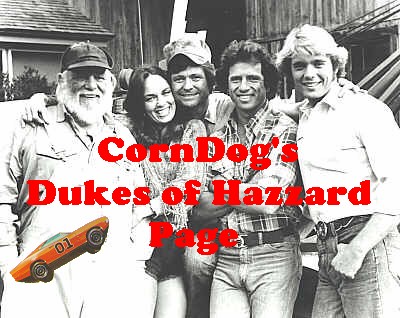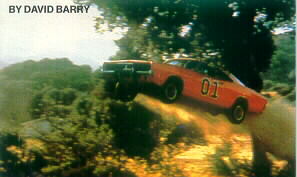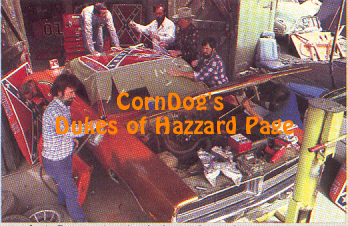
GO BACK HOME



We're talking, of course, about the famous "General Lee," the bright-orange, Southern dirt-road express with the Confederate flag on the roof and racing numbers on the doors. The children on the freeway are miserable seeing the wreck because they think the one and only General Lee is finished forever. They don't know that at any given time, several General Lees are ready for the sacrificial altar of The Dukes of Hazzard. The wild chase scenes and aerial stunts that delight Dukes fans eat up stunt cars at the rate of about three per episode, and the car on the truck is only one of several dozen General Lees used to film a season's worth of shows.
The studio press biography of the General Lee identifies it as a 1969 Dodge Charger with the 440-cubic-inch Magnum V8 engine, a big-block powerplant from the golden age of American muscle cars, before emissions controls and fuel-economy conserns shrank horsepower from maxi to mini. The '69 Charger had enough old-fashioned, stump-yanking muscle to smoke the tires on pavement and churn a country dirt road into the dust cloud that follows the General through the Hazzard County hollows.
The Charger not only goes fast, it looks fast. Brawny, tough, sleek, macho, and muscular, the car's lines ammounce it as ready to play automotive Superman whenever the Duke boys need to jump a roadblock, cross a ravine of fly over a Peterbilt tractor to lose the yowling black-and-white sheriff's cars in pursuit. With racing numbers and doors welded shut, the car brings to mind the legendary racing stock car driven to so many victories in 1967 and 1970 by seven-time Grand National NASCAR champion Richard Petty, a North Carolina native and hero-type who could name his own ticket if the South ever secedes and decides to elect a president.
But as perfect as the '69 Charger is for the role on The Dukes of
Hazzard, the choice was almost coincidental. Excutive producer Paul Picard and producer
Gy Waldron, creator of the show, wanted a late 1960's muscle car but had not decided which  one when the studio transportation captain showed them a 1969 Dodge Charger. They looked
no further. Orange was chosen as the best and brightest color, and numbers were added on
the door for the look of a racing stock car. Topping it off was the Confederate emblem on the
roof to envoke the flavor of a "Good Ol' Boy" car from the back country of sour-mash bourbon,
home-brewed white lightning from stills hidden in mountain hollows, Red Man chewing
tobacco and stock-car racing on Sunday afternoons.
one when the studio transportation captain showed them a 1969 Dodge Charger. They looked
no further. Orange was chosen as the best and brightest color, and numbers were added on
the door for the look of a racing stock car. Topping it off was the Confederate emblem on the
roof to envoke the flavor of a "Good Ol' Boy" car from the back country of sour-mash bourbon,
home-brewed white lightning from stills hidden in mountain hollows, Red Man chewing
tobacco and stock-car racing on Sunday afternoons.
Tthe cars used for the show have the favored-but-doomed status of a bull at a corrida de toros. Just a bull is carefully groomed, watered and pampered before a bullfight, the General is kept clean after every run throught dust, dirt or mud, shined and polished as if headed for a show instead of the stunt that may consign it to the scrap heap. The actors, staff and crew don't refer to the General as a car, let alone a prop. They call it "the General," the way the Duke boys and their family do in the show.
The name "the General" was created by Gy Waldron as part of the original Dukes script. As the show evolved and the General took on the dimension of a character, his popularity kept pace with that of the show's other characters.
The "Way Down South in the Land of Cotton" 12-note musical horn came into the show by another stroke of fate. Picard and Walton were on the highway in Georgia to film the first episodes of the show when they heard a "Dixie" horn, in a passing car.
"We made a U-turn and chased the car for about a dozen miles before we could flag it down," Picard says. "We told the kids in the car we wanted to buy their horn and they didn't want to sell. We kept upping the price and finally got it for about five times what it sold for in an auto-accessories store. We didn't know the musical horn was a stock item you can buy almost anywhere."
Picard is one of the few who have driven the General on the street. Though the show's mail indicates that there are dozens or hundreds of imitation Generals on the road all over the country, only a General used on the show can qualify as authentic. Picard took one home from the lot when his own car was in the shop.
"I was on the freeway," Picard says, "making sure I wasn't doing over 55, when I saw the red lights of the law in my mirrors."
A black-and-white California Highway Patrol car pulled alongside and the officer did a bug-eyed imitation of Sheriff Rosco Coltrane before pulling Picard over.
"I just had to stop you," the officer said, waving aside Picard's license. "Now I can go home and be a hero to my kids and tell them I stopped the General Lee."
The General Picard drove was what's known as a "First Unit" car. That means it was a car to be driven only by the stars, John Schneider and Tom Wopat, rather that a Second Unit car driven in stunts for the action sceenes. While First Unit and Second Unit cars look alike on screen, they are very different under the skin. All the Generals used on the show are beefed up with heavy-duty shocks absorbers and helper springs. The locking mechanism is disconnected from the foot-operated parking brake for the spectacular "Bootleggers' Turn," the 180-degree turns made so often by the Duke boys to evade the sheriff. The maneuver is named for the Southern moonshiners who, according to legend, used it routinely to shake off the pursuing "revenooers."
Besides the modification to the parking brake, every car gets a thorough tune-up, replacement carburators, glasspack mufflers, custom mag wheels and radial tires. But the cars used for the jumps and aerial stunts get far more modification. The jump cars are equipped with full roll cages -structures resembling Jungle Gymes built of thick, welded steel tubing to surround the driver and passenger compartment for protection under any circumstances. The jump cars also get boxes of lead weight in the trunk as ballast to keep the cars level in the air.

"Without the ballast to balance the weight of the engine in front," says Dukes Second Unit director and stunts coordinator Paul Baxley, "the car would turn end over end in the air. We use about 500 or 600 pounds of ballast for short jumps and up to 1000 pounds for long jumps."
Though the ballast keeps the car from turning over in flight, there is no way to cushion the landing.
"Once a car has jumped, it's finished," says Baxley, a former stunt driver. "The shock of the impact completely destroys the structural integrity of the car, even if there's no visible damage. We don't even drive a car on the show after it's been jumped. If the shot didn't come out right the first time, we do it again with another car."
The stars of the show are among the fans of the car. John Schneider says the '69 Charger was the best muscle car there ever was. "It was a great car for '69," he says, "and an even better car for now. There's nothing you can buy now that's American that's gonna go anywhere near as fast as that car." Catherine Bach says that the General Lee is "a lotta fun. I enjoy power in any car, and the General is an easy car to get a little wild in. It's always an adventure, especially when John or Tom is driving."
Fan mail to The Dukes of Hazzard runs about 60,000 pieces a month, more than half of that directed at the General Lee. A typical letter, received recently, asked if the cars wrecked on the show were for sale and, if so, for how much, and concluded with, "Please send me some posters of the General Lee and tell me what you put in the General Lee as engines, transmissions, and rims." Another letter said, simply, "I would like to know if you could send an autographed picture of the General Lee."
Yes, fans have asked for autographed pictures of the car - the autographs being prints of the tire tread made by driving the car over the photograph. Still somewhat in awe of the popularity of the cars, the producers have a message they would like to get across to Dukes fans - especially young ones who drive cars like the General on the street. Paul Picard wants to make it clear that the action sequences on the show are for stunt cars and stunt drivers only.
"For anybody to try anything like what we do on the show with their own car on the street would be a dangerous mistake," says Picarad. "Our stunt cars are extensively modified for the job and driven by specially trained stunt drivers."
And despite the modification, the stunt cars still get reduced to junk by every jump. Knowing the rate of attrition, where do all the Charger-Generals come from? "We buy them from private owners," says transportation captain Tom Greene, "mostly around the Los Angeles area." Green says the shopping for 1969 Chargers is an ongoing process.
"Our stock got low once, and we were down to leaving notes on windshields of Chargers in supermarket parking lots, asking if the owners wanted to sell us the car for the show." Greene says. The cars purchased uusually range from good to fair in condition. They are reconditioned and brought up to show standards by a team of mechanics and craftsmen on the lot.
"We cannibalize the cars that have jumped and been junked," Greene says. "So we've got a big stock of spares to replace missing or damaged pieces on the cars we buy."
Is there any danger, ultimately, of the Dodge 1969 Charger becoming extinct, or a valued rarity in the next few years? Would it be placed on the endangered-species list? Hardly. The kids in the car on the freeway have nothing to worry about: Chrysler Corporation sold about 85,000 1969 Dodge Chargers in the U.S. Even if half of those have already been scrapped, the ones still on the road would stock The Dukes of Hazzard for another 600 years.